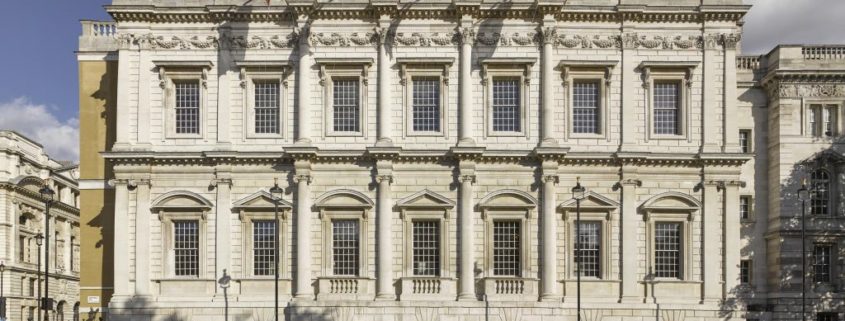Lord Mayor’s Talk on London’s Architectural Links with Dorset
At 2.30 p.m. on Tuesday 07 December at Gold Hill Museum, former Lord Mayor Sir John Stuttard will give an illustrated talk on the theme of London and Dorset: A Shared History in Construction. “The unique shelly appearance and subtle colour variations of Purbeck Marble”, according to Historic England, “made it the foremost decorative stone of the English medieval period. It was used extensively … in high-status buildings such as cathedrals, abbeys and palaces.” The brilliant white of Portland Stone was also attractive to architects. Inigo Jones used it, along with a honey-coloured stone from Oxfordshire and a pinkish-brown stone from Northamptonshire, to embellish the Banqueting House (above), rebuilt in Whitehall for James I. “In the early 17th century, the shortage of Portland stone often held up the work”, says the Historic Royal Palaces Guidebook. “Seven hundred pounds was paid by the Crown to build a new loading jetty at Portland, Dorset, and a prohibition was placed on the quarry owner against supplying private customers at higher prices than the Crown was prepared to pay.”
In 1666 much of London was destroyed in the Great Fire. Sir Christopher Wren’s decision to rebuild St Paul’s Cathedral substantially in Portland Stone created a huge demand – nearly a million cubic feet of stone was used – and established a regular trade by sea to the Thames. Portland Stone became the fashionable choice for notable Georgian buildings such as the British Museum, Somerset House, the Bank of England, the National Gallery, and Mansion House, official residence of Lord Mayors of London like Sir John. Chief architect of the Bank, Sir John Soane, was responsible for the present-day appearance of the Banqueting House when he decided in the early 19th century to clad it in Portland Stone.
The links between Swanage and London were reinforced when John Mowlem (1788-1868), stonemason and son of a Swanage quarryman, moved to London in 1807. After working on Nelson’s Tomb in St Paul’s and on Somerset House, he set up a thriving business as a paving contractor and stone merchant, in which he was joined by George Burt (his wife’s nephew) and Joseph Freeman (Burt’s brother-in-law). Eventually Mowlem returned to Swanage and in the absence of any Mowlem heirs the company passed to Burt, while retaining the Mowlem name to the present century. As Sir John observes, “they brought back to Swanage from London some interesting artefacts, in a Victorian example of recycling building materials and architectural salvage.”
Please don’t attend this talk if you have reason to believe that you may have Covid or recently been exposed to the virus. The Garden Room will be well ventilated and the seats will be more spaced out than they used to be, with an inevitable reduction in capacity. S&DHS members will have until 2.20p.m. to claim a seat.
Details of our monthly lectures can be found by clicking here





